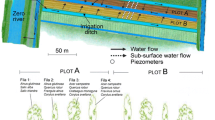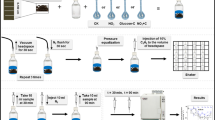Abstract
Denitrification losses were measured using the acetylene inhibition technique adapted for a coring procedure. Two soils under a cut ryegrass sward were used. One soil was a freely-drained clay loam receiving under 900 mm rainfall annually, the other soil being a poorly-drained silty clay receiving over 1100 mm rainfall annually. Swards at each site received up to 300 kg N ha−1 yr−1 of calcium ammonium nitrate (CAN), urea or a new fertiliser mixture GRANUMS (30% ammonium nitrate, 30% urea, 10% ammonium sulphate, 30% dolomite). For both soils the rate of denitrification exceeded 0.1 kg N ha−1 day−1 only when the air-filled porosity of the soil was < 30% v/v and soil nitrate was > 2 mg N kg−1 in the top 10cm of the profile and when soil temperature at 10 cm was > 4°C. When the soils dried such that their air-filled porosity was > 30% v/v, denitrification rates decreased to < 0.08 kg N ha−1 day−1. Highest rates (up to 3.7 kg N ha−1 day−1) were observed on the clay soil following application of 94 kg N ha−1 CAN to soil near field capacity in early summer 1986. Losses from CAN were approximately 3 times those from urea for a given application. Denitrification losses from the GRANUMS treatment were, overall, intermediate between those from CAN and urea but the daily losses more closely resembled those from the CAN treatment. The impeded drainage on the clay soil, where soil moisture contents remained close to field capacity throughout the year, showed denitrification losses roughly 3 times those observed on the more freely drained clay-loam for any given treatment. Over a 12-month period, N losses arising from denitrification were 29.0 and 10.0 kg N ha−1 for plots receiving 300 kg N ha−1 CAN and urea, respectively, on the well drained clay-loam and 79.0 and 31.1 kg N ha−1 respectively, for identical plots on the poorly drained clay soil. Annual denitrification losses from control plots were < 1 kg N ha−1 on both soils.
Similar content being viewed by others
References
Burg PFJ van, Dilz K and Prins WH (1982) Agricultural value of various nitrogen fertilisers. Netherlands Nitrogen Technical Bulletin 13, Agricultural Bureau of the Netherlands Fertiliser Industry, The Netherlands
Chalamet A (1985) Effects of environmental factors on denitrification. In: Golterman H L (ed.), Denitrification in the nitrogen cycle, pp 7–29. NATO Conference Series. New York: Plenum Press
Department of Agriculture for Northern Ireland (1987) Statistical review of Northern Ireland agriculture 1986, pp 38 and 52. HMSO, Belfast
Fenn LB and Hossner LR (1985) Ammonia volatilisation from ammonium or ammonium-forming nitrogen fertilisers. In: Stewart BA (ed.), Advances in Soil Science Vol I, pp 123–169. New York: Springer-Verlag
Garrett MK (1987) The rationale for mixed ammonium nitrate—urea fertilisers and assessment of granular products. Proceedings of the Fertiliser Society (London) 257, 36 pp
Greenwood DJ (1963) Nitrogen transformations and the distribution of oxygen in a soil. Chem and Ind 2: 799–803
Jordan C and Smith RV (1986) Losses of nitrogen from an intensively managed grassland ecosystem. Department of Agriculture for Northern Ireland, Report on Research, Development and Technical Work, pp 123–131
Jordan C and Smith RV (1985) Factors affecting leaching of nutrients from an intensively managed grassland in County Antrim, Northern Ireland. J Env Management 20: 1–15
Keatinge JDH, Stewart RH and Garrett MK (1979) The influence of temperature and soil water potential on the leaf extension rate of perennial ryegrass in Northern Ireland. J Agric Sci Camb 92: 175–183
Ministry of Agriculture, Fisheries and Food (1983) Sampling soil for analysis. Leaflet 655 HMSO, London
Morrison J, Jackson NV and Sparrow PE (1980) The response of perennial ryegrass to fertiliser nitrogen in relation to climate and soil. The Grassland Research Institute, Hurley, England
Murphy WE (1983) Comparing urea and CAN at different locations. Farm and Food Res 14: 41–43
Ryden JC, Skinner JH and Nixon DJ (1987) A soil core incubation system for the field measurement of denitrification using acetylene-inhibition. Soil Biol and Biochem 19: 753–758
Ryden JC (1985) Denitrification loss from managed grassland. In: Golterman HL (ed.) Denitrification in the nitrogen cycle, pp 121–134. NATO Conference series. New York: Plenum Press
Ryden JC (1984) The flow of nitrogen in grassland. Proceedings of the Fertiliser Society (London) 229, 44 pp
Ryden JC, Ball PR and Garwood EA (1984) Nitrate leaching from grassland. Nature 311: 50–53
Ryden JC (1983) Denitrification loss from a grassland soil in the field receiving different rates of nitrogen as ammonium nitrate. J Soil Sci 34: 355–365
Ryden JC and Dawson KP (1982) Evaluation of the acetylene-inhibition technique for the measurement of denitrification in grassland soils. J Sci Food Agric 33: 1197–1206
Scheiner D (1976) Determination of ammonia and kjeldahl nitrogen by indophenol method. Water Res 10: 31–36
Smith RV and Jordan C (1987) The fate of nitrogen and phosphorus in a rural ecosystem. Department of Agriculture for Northern Ireland, Annual Report on Research, Development and Technical Work, pp 41–49
Stewart BM (1987) Ion chromatographic determination of nitrate in 2 molar potassium chloride soil extracts. J Soil Sci 38: 415–419
Tabatabai MA (1982) Soil enzymes. In: Page AL (ed.) Methods of Soil Analysis Part 2, pp 903–947. Madison, Wisc: American Society of Agronomy
Tiedje JM (1982) Denitrification. In: Page A L (ed.) Methods of Soil Analysis Part 2, pp 1011–1026. Madison, Wisc.: American Society of Agronomy
Watson CJ (1987) The comparative effect of a mixed urea, ammonium nitrate, ammonium sulphate granular formulation on the efficiency of N recovery by perennial ryegrass. Fert Res 14: 193–204
Watson CJ (1986) Preferential uptake of ammonium nitrogen from soil by ryegrass under simulated spring conditions. J Agr Sci Camb 107: 171–177
Author information
Authors and Affiliations
Rights and permissions
About this article
Cite this article
Jordan, C. The effect of fertiliser type and application rate on denitrification losses from cut grassland in Northern Ireland. Fertilizer Research 19, 45–55 (1989). https://doi.org/10.1007/BF01080685
Received:
Accepted:
Issue Date:
DOI: https://doi.org/10.1007/BF01080685




